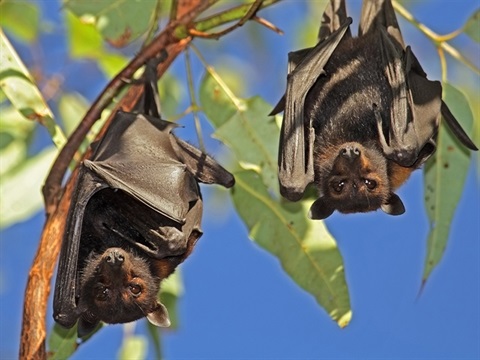Flying-foxes

Kempsey Shire is home to a large number of flying-foxes. Flying-foxes are native mammals that roost in trees by day and fly out at night to feed on tree nectar, flowers and fruits. They have excellent senses, including eyesight and smell, and can fly up to 100km to forage each night.
Flying-foxes are protected
The Grey-Headed Flying-Fox is listed as a species that is ‘vulnerable to extinction’ under the federal Environment Protection and Biodiversity Conservation Act 1999 and the NSW Biodiversity Conservation Act 2016.
Flying-foxes play an important role
Flying-foxes feed on flowers, nectar and the fruits of eucalyptus, melaleuca, banksia, lily pilly, figs and other species of trees and shrubs. They play an important role in pollinating plants and dispersing seeds, which helps to maintain the health of our native forests. One flying-fox can disperse up to 60,000 seeds in a single night.
Flying-fox locations
As social animals, flying-foxes congregate in camps to roost, find a mate and feed their young.
Kempsey currently has one permanent camp of flying-foxes at Rudder Park, which includes the species:
There are 11 recorded locations of flying-fox camps across the shire.
Nationally important flying-fox camps
- Kempsey Cemetery, February 2020
- Jerseyville, Rotary Park, May 2019
Other flying-fox camps
- Kempsey, Rudder Park, February 2020
- Arakoon, February 2018
Historic flying-fox camps
- Aldavilla
- Bellbrook
- Clybucca
- Crescent Head
- Kempsey, Crescent Head Road
- Kempsey, Deep Creek
- Kempsey, Jocks Crossing
The National Flying-Fox Monitoring Viewer provides a map of flying-fox camp locations.
Council’s role
Kempsey Shire Council does not manage flying-fox colonies on private land or Crown land across Kempsey Shire and can’t interfere with a colony in any way to move it on.
Council has a management plan in place for the flying-fox camp at Rudder Park, East Kempsey, to minimise the impacts of the species on nearby residents. The objectives of the Rudder Park Flying-Fox Camp Management Plan(PDF, 7MB) are to:
- manage community impacts and concerns about the camp
- ensure the welfare of the flying-foxes and their conservation in appropriate locations
- ensure Council meets its legislative responsibilities in all management activities.
The plan was developed after an extensive community engagement program and endorsed at the October 2017 Council meeting.
The engagement page can be viewed on Your Say Macleay
Health concerns
Human infections with viruses carried by flying-foxes are very rare. There is no risk of infection if you don’t make physical contact with a flying-fox, and there are no reports of people contracting diseases from living close to flying-fox camps.
If you accidentally touch flying-fox faeces or urine, washing your hands with soap and water is an adequate level of hygiene. More information is available from NSW Health.
What to do if you find a flying-fox on the ground
If you find a flying-fox alone or on the ground, it may be sick or injured. Don’t approach or touch the animal; instead call FAWNA on 6581 4141. A trained wildlife rescuer will be dispatched to collect and care for the animal.
Flying-fox myths
Flying-foxes are pests and serve no purpose in our environment.
False. Flying-foxes play a vital role in pollination and seed dispersal in our native forests.
Flying-foxes are dirty animals.
False. Flying-foxes are exceptionally clean animals that constantly groom themselves. They also invert or hang right side up to avoid soiling themselves.
You can catch Australian Bat Lyssavirus if you touch flying-fox droppings.
False. There have been only three confirmed cases of Australian Bat Lyssavirus in humans. These all occurred in Queensland and involved people being scratched or bitten while handling flying-foxes.
More information
You can find more information about flying-foxes on the NSW Department of Planning, Industry and Environment website. This includes information about living near flying-fox camps and the latest research on flying-foxes.